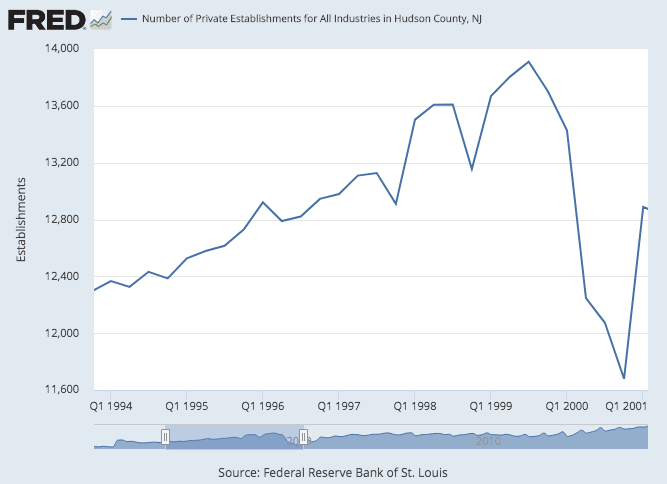
By the time my family arrived in this country, the slow decline of embroidery had begun. There were enough jobs to go around in embroidery, but it had competition in manufacturing of all kinds, from K-Mart to the hose factory. The tradition of the industrial Northeast that began long before the Civil War continued into the second half of the 20th century, but smaller manufacturing businesses kept Union City afloat, the kind of family affairs that Karabin described the Germans building in the late 1800s.
The bigger corporations immediately began seeking a way out when it became apparent that the labor movement would win in securing legal safeguards for the dignity of the American worker.
“Sectors of manufacturing like that which are, of course, labor intensive and low wage got hit first by the opening of the U.S. economy to trade,” Tonelson, the economist, told me. “Their troubles began long, long ago, long before NAFTA – although NAFTA hurt a lot – but long before China and, in fact, the first wave of losses of those kinds of manufacturing jobs from the Northeast went not overseas, they went to the South.”
“There were no unions, wages were a lot lower, and there they went,” he narrated. Southern states have also traditionally maintained lower tax rates for businesses and generally meddled less in corporations’ affairs, which also presented an attractive prospect for corporations.

The working class immigrants of Union City weren’t moving to the South. The businesses that bought their products were buying from the South, elbowing them out of the market. According to a New York Times analysis of the North Jersey embroidery industry from the time, the state’s share of national embroidery output dropped 20 percent from 1983, the year my mother was hired at the Secaucus tablecloth factory, to 1998. But that still left New Jersey 70 percent of the national market.
“Foreign and domestic competition and the more austere fashion trends of recent years have driven a number of family-owned companies out of business,” the Times concluded. “While some manufacturers take heart from recent signs that embellishment is returning to women’s apparel, many others are so demoralized that they have ignored offers of state aid to help them modernize their operations.”
Domestic trade was not the death knell of embroidery in Union City. The decisions that deleted factory culture from American DNA were not made so close to home. As evidence, note this New York Times assessment of New Jersey manufacturing just four years later, in 2002:
While New Jersey is typically viewed as a state of bedroom communities and shopping malls, it is every bit a major player in the international economy, supporting an estimated 600,000 jobs with global trade.
New Jersey ranks eighth among states in the dollar value of its exports at $25.93 billion in 2001, according to data provided by the United States Commerce Department. To be sure, a strong dollar and a sluggish economy overseas drove exports down 9.88 percent in 2001 after a major boom in the late 1990’s. But that was after a 36.9 percent increase in 2000 from $21 billion in 1999.
”It’s clear that New Jersey is a powerhouse when it comes to international business and international trade,” said Joe Gonzalez, president of the New Jersey Business and Industry Association.
It would be international trade – the factories of North America, first, then Asia – that would force most of the now-fully-American families of North Hudson to shut down operations.
“This process of globalization will not be reversed – it will accelerate. Throughout the world, economic and technological forces are breaking down walls, reaching across borders, and weaving together a single world economy.”
Renato Ruggiero, director-general of the WTO, in a 1997 speech in Beijing
The Hudson Reporter, a local newspaper, looked back at the industry in 2000, two years before China would join the World Trade Organization – a move global economic leaders spent much of the 1990s calling necessary for American prosperity.
“By the early 1990s, the local industry had suffered severe losses in business and in its manufacturing employment, though it continued to produce more than 70 percent of the nation’s embroidery output,” the newspaper noted. “However, the major loss of business came from the growing overseas markets.”
“Three major problems that the industry has faced are loss of market shares to foreign competition, the need for modern equipment and the computerization of the industry, which makes more training necessary, especially for the Internet,” it continued, quoting Leonard Seiler, executive director at the time of the group responsible for the “Embroidery Capital of the World” sign, Schiffli Lace and Embroidery Manufacturing Association Inc.
“We spend $100 a day in wages as opposed to the $100 a month in wages paid overseas,” said Seiler. “That is tough competition.”

By then, the work of the Clinton administration in securing profits for Canadian and Mexican manufacturers in the United States had been completed. NAFTA – the North American Free Trade Agreement, the crowning economic achievement of the Clinton era – was signed in 1994, encouraging big business to invest in manufacturing and compete with family-run small businesses. Washington, DC, think tanks rejoiced.
“NAFTA is blamed for U.S. job losses or declining living standards of workers, particularly among unskilled persons. In reality, the impact of NAFTA on gross job displacement in the United States has been negligible,” the Brookings Institution declared in 1997. “Furthermore, there is some evidence that the net employment effect (the difference between jobs displaced and jobs created) has been positive.”
“[T]he North American Free Trade Agreement has been a success by any measure. The job ‘losses’ that critics of free trade blame on NAFTA are mostly fictitious, based on the misuse of trade deficit numbers,” the Cato Institute contended a year later. “About 150,000 Americans have filed for benefits under a program for workers allegedly displaced by increased imports from Mexico and Canada. As painful as the displacement may be for those workers, the U.S. economy during the last four years has created that many net new jobs approximately every three weeks.”
The Brookings Institution critique urged the federal government to indoctrinate Americans to like NAFTA through a “systematic public education effort … about NAFTA and its actual effects.”
The D.C. reality, like it so often does, did not match testimonies from Union City embroiderers. Bruce Altman and Ignacio Camacho, who ran the business A Touch of Lace in the city, told the New York Times that foreign competition was evaporating the market for their trade, which consisted mostly not of consumers buying a final product, but designers and manufacturers buying embroidery materials from the factories, often wholesale.
“What’s happening is, the customer base is less now, less people to sell to in this country. We have to go elsewhere to do business. A lot of goods are going to Mexico, you know, with NAFTA. That’s hurt our industry tremendously,” Altman said. Answering a different question, he added, “Too much importation of garments from Central and South America, Taiwan, Japan. The people in this county, every day, are losing jobs.”
Both Camacho and Altman denied that automation, digitalization, or technology generally had hurt the job market.
“The computer is good for the people and for the company. You need too much room for the paper punch (perforated paper rolls that instruct machines to follow a lace pattern),” Camacho told the Times. “Now, with the computer, you only use the disk. Nobody lost their job because of the computer.”
“By the 1980s, ‘90s, as we expanded trade with countries like Taiwan and South Korea – which were still relying pretty heavily on their apparel industries for employment and growth although they were also moving into heavier manufacturing,” Tonelson noted in his conversation with me. “Once those countries got too expensive they started going to Mexico. And once that got too expensive, they started going to China.”
While the think tanks sold NAFTA, the World Trade Organization (WTO) made its impassioned plea to let communist China, a repressive regime that banned citizens from engaging in any economic activity that did not directly benefit the Party’s quest for world domination, enter the free world’s market.
“The basic fact is that China is moving to the very center of the globalization process, and both China and other nations are benefiting from it,” Renato Ruggiero, the director-general of the WTO, said in a speech in Beijing in 1997. “We live in a world where technology, capital, and trade move increasingly more freely; where the old economic tools have lost their edge; and where economic strength and security increasingly depend on economic openness and integration. China’s path to growth and modernization is also a path to interdependence.”

“This process of globalization will not be reversed – it will accelerate. Throughout the world, economic and technological forces are breaking down walls, reaching across borders, and weaving together a single world economy,” Ruggiero continued. “Deepening interdependence is the central reality for China and for the world. Managing interdependence is our shared responsibility.”
Bill Clinton failed to bring China in completely in the 1990s. In 1999, deep into the political scandal that taught my generation what oral sex was, Clinton still found time to sell entangling an economy of American family businesses with an economy we now know was engaging in black market live organ harvesting from political prisoners at the time.
“Today China embraces principles of economic openness, innovation and competition that will bolster China’s economic reforms and advance the rule of law,” Clinton said in November 1999, signing a trade agreement that CNN claimed opened up the Chinese market to American creators. It technically did open up some industries to China: Hollywood, big banks, Boeing aircraft. Small labor was left in the dust.
Clinton correctly predicted the agreement was “a profoundly important step in the relationship between the United States and China” that brought China one step closer to membership in the World Trade Organization.
“In the 1990s, Americans were told that trade with Mexico and China would create more customers for American made goods and any jobs that we lost would be replaced by higher-paid, higher-skilled jobs,” John Carney, Breitbart News’ economics editor and our resident expert on all things finance, told me. I had reached out for help understanding economic data from the early aughts. “We’d ship jobs Americans did not have to do anymore to our trading partners and create better jobs at home. Sadly, for many communities, the factory gates closed and the promised new jobs never showed up.”
He then directed me to this graph, which shows the number of private businesses in Hudson County between 1994 and 2001.

The dip does not correspond to a similar rise in the unemployment rate – bizarrely, the unemployment rate drops significantly around the same time before the country enters a recession and the rate skyrockets again – suggesting that the overall job market was unaffected by the policies. They only destroyed local businesses, leaving a vacuum for big business to exploit and local government to hastily try to salvage.

“[New Jersey has] done much worse in keeping manufacturing jobs since 2001 certainly as the U.S. as a whole and even … Hudson [County] has lost more,” Tonelson noted. “In January 2001, it had 20,500 or so [jobs] and that’s down to 9,300, so its definitely lost manufacturing workers faster. And it’s also interesting that unlike the rest of the country, it lost the workers fastest before the great recession hit at the end of 2007.”
COMMENTS
